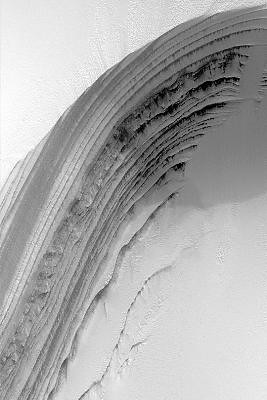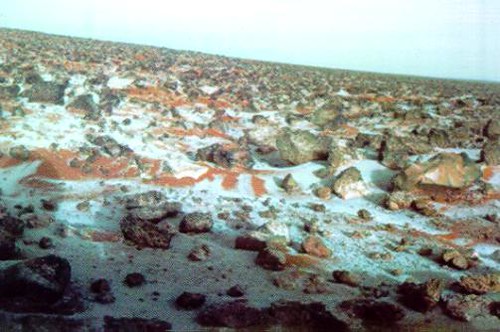New Mars Forums
You are not logged in.
- Topics: Active | Unanswered
Announcement
Pages: 1
#1 2013-07-11 08:32:35
- Vincent
- Banned
- From: North Carolina USA
- Registered: 2008-04-13
- Posts: 623
Mars Weather, Geology, for Real
Just looking over some images and "believe" I can make some reasonable arguments for dynamic Mars weather, geological events occurring now on Mars. These go against the mainstream but are not without evidence by current probes. I am not a geologist, but out gassing is a result of subterranean events. Evidence of these will be presented with surface and orbital observation.
The low pressures on mars do develop air masses and areas of divergence, subsidence, convergence and convection. The hydro cycle is always involved, Sublimation and cooling and condensational latent heat drives a thermal gradient wind. Earth analogs are rare but do and can occur.
The first link is from with Mars Global Surveyor. A cropped image from this link:
http://www.msss.com/mars_images/moc/wea … tion02.jpg
This link is a crop:
http://www.flickr.com/photos/11627092@N06/9263003700/
This is a surface analysis of the above crop. This looks like an Earth weather map, but it showed be understood that pressure differences are small, but are present. The dynamics or winds, are thermal with only a small pressure gradient influence.
This image is significant because of air mass migration and atmospheric mixing southward to near 10 degrees latitude No water vapor is condensed to the point of visible accumulation. Keep in mind this image was taken in 2002 when visible color was either questioned and often edited to adhere to current theory. That being said, the dynamics cannot be denied, no matter the visible color depiction.
http://www.flickr.com/photos/11627092@N06/9263008448/
More to come....
Last edited by Vincent (2013-07-11 08:49:33)
Argument expected.
I don't require agreement when presenting new ideas.
-Dana Johnson
Offline
Like button can go here
#2 2013-07-11 08:46:35
- Vincent
- Banned
- From: North Carolina USA
- Registered: 2008-04-13
- Posts: 623
Re: Mars Weather, Geology, for Real
To understand the color editing and image quality restrictions for public consumption by NASA, I present one more image. This image was presented by NASA just before Curiosity landed. Have you ever seen such a detailed "true color" image from Mars before? They got'em.
My link:
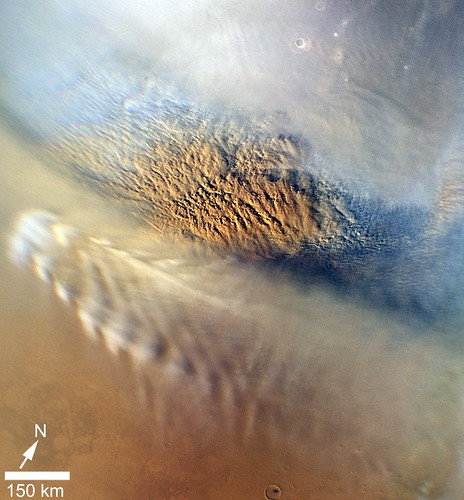
672847main_vasavada-4_full by dfrank39, on Flickr
Last edited by Vincent (2013-07-18 12:14:37)
Argument expected.
I don't require agreement when presenting new ideas.
-Dana Johnson
Offline
Like button can go here
#3 2013-07-11 09:33:34
- Vincent
- Banned
- From: North Carolina USA
- Registered: 2008-04-13
- Posts: 623
Re: Mars Weather, Geology, for Real
The next discussion is about water influence. Now, any reasonable mind would proclaim that without a renewed source of water, then, all water would be frozen and buried in dust. If this sounds reasonable, it is because, it is reasonable.
So where is the water coming from? Out gassing.
So the visible evidence should present a dust covered Mars, that it doesn't, or, the visible evidence should present both a renewed ice layer and out gassing.
The "fact" that new ice forms at the poles each winter is without question. Without renewal, this would end. The orbital satellites show, not only the current water interaction, but, out gassing evidence.
Current water vapor interaction. Orographic lift occurs as upslope conditions develop. Earth analog is along the front range of the Rocky Mountains in the U.S.
This image shows orographic lift and layered development of a visible accumulation of water vapor. This is logical, not only in physical development, but in visible presentation.
Source:
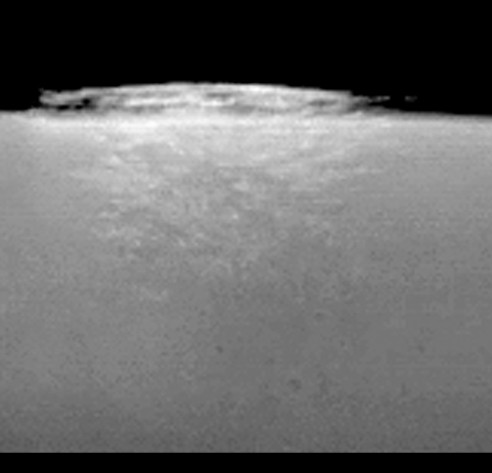
2002_06_18_24 by dfrank39, on Flickr
Cropped, magnified and rotated:

2600837350_752bfdc47d_o by dfrank39, on Flickr
This image, high ice cloud over Mars' limb. This composite of red and blue Mars Global Surveyor (MGS) Mars Orbiter Camera (MOC) images acquired on 6 July 2005 shows an isolated water ice cloud extending more than 30 kilometers (more than 18 miles) above the Martian surface.
That was posted long time ago The visible presentation is different, because there is a difference. It is a plume at the base of a volcano. The visible presentation is different, because the source is different. We have seen orographic atmospheric water vapor moisture in a satellite visible presentation. This is water vapor out gassing....
Can you tell the difference?
http://www.flickr.com/photos/11627092@N06/9262997840/
Last edited by Vincent (2013-07-18 12:02:09)
Argument expected.
I don't require agreement when presenting new ideas.
-Dana Johnson
Offline
Like button can go here
#4 2013-07-11 09:53:17
- Vincent
- Banned
- From: North Carolina USA
- Registered: 2008-04-13
- Posts: 623
Re: Mars Weather, Geology, for Real
As far as surface conditions I present the current Gale Crater images. It shows rocks and dust, as it should.
Curiosity Sol 329:
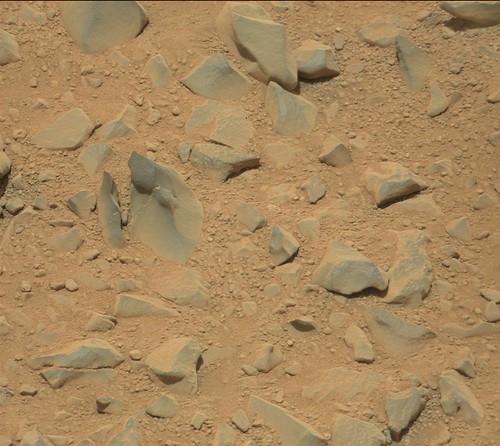
0329MR1334000000E1_DXXX by dfrank39, on Flickr
Miridiani Sol 120 or about:
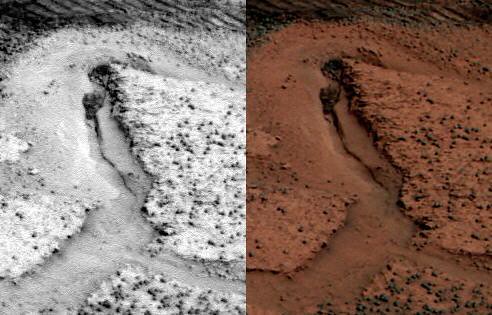
sol 122 by dfrank39, on Flickr
Can you tell the difference?
The bottom line is an impact region, vs. a natural deposition area with outgassing....
Vincent
Last edited by Vincent (2013-07-18 12:08:37)
Argument expected.
I don't require agreement when presenting new ideas.
-Dana Johnson
Offline
Like button can go here
#5 2013-07-18 12:59:51
- Vincent
- Banned
- From: North Carolina USA
- Registered: 2008-04-13
- Posts: 623
Re: Mars Weather, Geology, for Real
Some really cool water snow drifts against the polar scarp. This is upslope precipitation "off the chain." It's like Denver Colorado on steroids....
Can we say, "front range."
Argument expected.
I don't require agreement when presenting new ideas.
-Dana Johnson
Offline
Like button can go here
#6 2013-07-18 13:10:32
- Vincent
- Banned
- From: North Carolina USA
- Registered: 2008-04-13
- Posts: 623
Re: Mars Weather, Geology, for Real
How do I know it is water ice? Because it disappears in a season. Believe it or not, CO2 ice can be buried and can be residual...
Vincent
Cyclonic storms do develop in "ideal" conditions on Mars. Surface water snow can and does reach the surface on occasion. This MOC image does show, or give a visible presentation of residual water snow in the late spring...
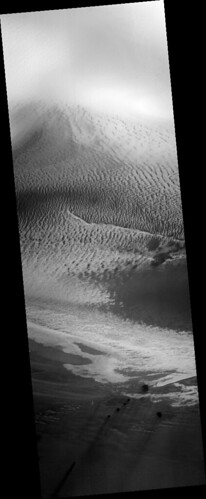
snow storm by dfrank39, on Flickr
Viking saw it on the surface....
Argument expected.
I don't require agreement when presenting new ideas.
-Dana Johnson
Offline
Like button can go here
#7 2013-07-18 13:28:56
- Vincent
- Banned
- From: North Carolina USA
- Registered: 2008-04-13
- Posts: 623
Offline
Like button can go here
#9 2013-07-22 10:38:49
- Vincent
- Banned
- From: North Carolina USA
- Registered: 2008-04-13
- Posts: 623
Re: Mars Weather, Geology, for Real
Do we need to go Newton Crater..... That aint dust....
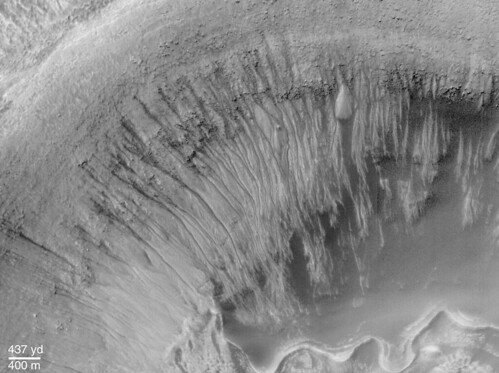
marsnewton_mgs_big by dfrank39, on Flickr
Argument expected.
I don't require agreement when presenting new ideas.
-Dana Johnson
Offline
Like button can go here
#10 2013-07-22 11:02:08
- Vincent
- Banned
- From: North Carolina USA
- Registered: 2008-04-13
- Posts: 623
Re: Mars Weather, Geology, for Real
The green green grass of home...
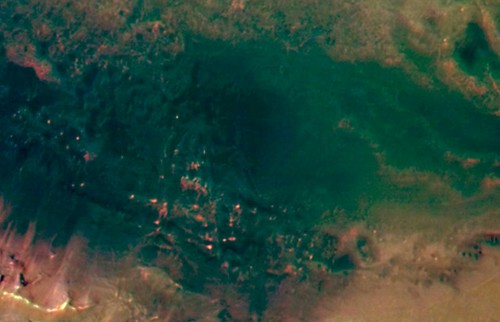
44eeb15b-19f3-4ac4-97e1-d44b4e5d45bc113 by dfrank39, on Flickr
Last edited by Vincent (2013-07-26 07:59:26)
Argument expected.
I don't require agreement when presenting new ideas.
-Dana Johnson
Offline
Like button can go here
#11 2013-07-26 08:43:57
- Vincent
- Banned
- From: North Carolina USA
- Registered: 2008-04-13
- Posts: 623
Re: Mars Weather, Geology, for Real
This image speaks of a cold dusty world. Visibility reduced in dust to around 3 nautical miles. Temperature data from REMS, seems to have been suspended from public viewing. Night-time temps are warmer no doubt, Day-time temperatures, colder. Unexpected swings due to inversions and hyper cooling most likely.
So, cold and dusty conditions. Is this a local event or is this a precursor to a regional event? It is hard to argue that liquid water could ever exist in this environment, that's because. "it could not." Transient liquid water requires clear skies and unrestricted visibilities. This allows for cooling to saturation at night, and warming of ground temperatures above 0C for pure water during the day. The source is atmospheric. How water got into low levels at the equatorial regions is problematic. We can debate that issue, but it does not matter, it is there with saturation and associated frost.
This could be the reason no dust devils have been seen. The crater makes a dust devil on such a large scale that it engulfs the entire crater as it circulates around Mt Sharp. This grand scale makes the winds much weaker. All we are left with are dusty skies.
Vincent
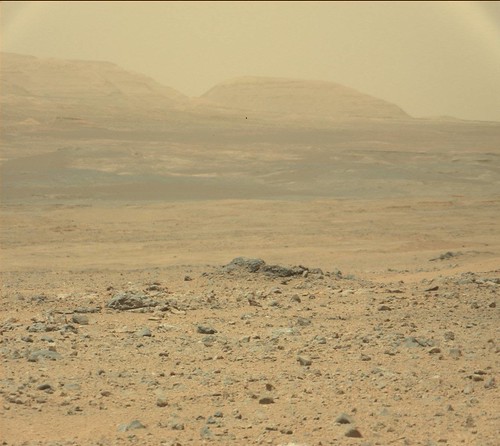
0343MR1388000000E1_DXXX by dfrank39, on Flickr
Argument expected.
I don't require agreement when presenting new ideas.
-Dana Johnson
Offline
Like button can go here
#12 2022-09-02 11:23:51
- Mars_B4_Moon
- Member
- Registered: 2006-03-23
- Posts: 9,776
Re: Mars Weather, Geology, for Real
First underground radar images from Mars Perseverance rover reveal some surprises
Offline
Like button can go here
#13 2022-09-12 13:32:18
- Mars_B4_Moon
- Member
- Registered: 2006-03-23
- Posts: 9,776
Re: Mars Weather, Geology, for Real
Siccar Point on Mars
Offline
Like button can go here
#14 2022-09-12 17:59:13
- SpaceNut
- Administrator
- From: New Hampshire
- Registered: 2004-07-22
- Posts: 30,153
Re: Mars Weather, Geology, for Real
So, when we can put boots on ground as I cannot wait any longer.
Offline
Like button can go here
#15 2023-01-21 19:32:41
- tahanson43206
- Moderator
- Registered: 2018-04-27
- Posts: 23,817
Re: Mars Weather, Geology, for Real
The report quoted below is about confirmation that a 1000 mile long water cloud occurs on Mars near Arsia Mons, at a certain time of the year, when conditions are just right ...
https://www.msn.com/en-us/news/technolo … 2988d8f5d4
Mashable
View Profile
An enormous Martian cloud returns every spring. Scientists found out why.
Story by Elisha Sauers • 12h ago
9 CommentsA cloud longer than California streaks across Mars' ruddy cheek. It looks as though an impressionist painter loaded his palette knife with white and scraped a line across the canvas as far as the oily paint would travel.
This is not what astrophysicist Jorge Hernández Bernal first saw in 2018 when the Mars Express Visual Monitoring Camera — affectionately known by the European Space Agency as the Mars webcam — posted a new picture. To the average eye, it was grainy and inscrutable, with the resolution of a standard computer camera circa 20 years ago. But Bernal, who was studying Martian meteorology at the University of the Basque Country in Spain, immediately recognized the shadow as something else: a mysterious weather phenomenon happening on the Red Planet.
It wasn't until researchers looked at the cloud with better equipment that Mars revealed the cloud in all its sprawling glory. The team dug deeper into photo archives, and discovered it had frequently been there. It was there through the aughts, and it was even there during NASA's Viking 2 mission in the 1970s.
A low-resolution camera on the European Space Agency's Mars Express probe first captured the enormous cloud in 2018.
© Provided by Mashable
The secret had been knowing when to look for it."There were people thinking ESA was faking it," Bernal told Mashable. "It was a bit hard because I was really young at the time [of the discovery], and I was on Twitter trying to speak to people."
Bernal and his team published their observations in 2020, dubbing it the Arsia Mons Elongated Cloud, or AMEC for short. With the cloud spanning 1,100 miles, scientists believe it could be the longest of its kind in the solar system. That work was followed with a second report, recently published in the Journal of Geophysical Research: Planets, revealing just how the volcano makes this extraordinary cloud, alone in an otherwise cloudless southern Mars that time of year.
"There were people thinking ESA was faking it."
How scientists discovered Mars' long cloud
For decades, the icy cloud arrived at sunrise on the western slope of Arsia Mons, an extinct volcano. The once lava-spewing ancient mountain is about 270 miles wide at the base and soars 11 miles into the sky. It dwarfs Mauna Loa, the largest Earth volcano, which is about half its height.The curious case of the gigantic cloud is how it escaped notice for so long. But some of the spacecraft around Mars, such as NASA’s Mars Reconnaissance Orbiter, are in orbits synchronized with the sun, meaning their cameras can't take pictures until the afternoon. By that time, the fleeting cloud, which lasts only about three hours in the morning, is already gone.
Related video: Odd Elongated Martian Cloud Spied By Orbiter (Dailymotion)
The Mars Webcam wasn't originally meant for science. Its purpose was to provide visual confirmation that ESA's Beagle 2 lander had separated from the Mars Express spacecraft in 2003. In hindsight, the space agency is glad it decided to turn the basic camera back on.
A simple camera not even intended for science on the European Space Agency's Mars Express spacecraft photographed the enormous cloud.
A simple camera not even intended for science on the European Space Agency's Mars Express spacecraft photographed the enormous cloud.© Provided by Mashable
Just as southern Mars experiences spring, the cloud grows and stretches, making a wispy tail like a steam locomotive, over the mountain's summit. Then, in a matter of hours, the cloud completely fades away in the warm sunlight.For a young scientist working on his doctorate degree, the natural wonder became a sort of muse. While the realist in him said that recreational space travel is impractical — perhaps even unethical given the world's climate problems — he couldn't help but try to draw what the cloud might look like from the ground.
"I keep imagining how it would be for a little civilization to have this huge cloud every year at the same time, like maybe the solstice is something for them like a coat," he said, smiling. "This is the imagination part."
Why Mars' Arsia Mons makes the gigantic cloud
So what makes this strange, stringy cloud?
For starters, it's not smoke billowing from a volcanic eruption. Scientists have long-known the volcanoes of the Red Planet are dead. Rather, it's the so-called "orographic effect:" the physics of air rising over a mountain or volcano.
The researchers ran a high-resolution computer simulation of Arsia Mons' effect on the atmosphere. Strong winds whip at its foot, making gravity waves. Moist air is then temporarily squeezed and driven up the mountainside. Those drafts blow up to 45 mph, forcing the temperature to plunge by more than 54 degrees Fahrenheit. This allows water to condense and freeze at about 28 miles above the volcano's peak.
Want more science and tech news delivered straight to your inbox? Sign up for Mashable's Top Stories newsletter today.
"I keep imagining how it would be for a little civilization to have this huge cloud every year at the same time, like maybe the solstice is something for them like a coat."
The enormous Arsia Mons cloud returns year after year in Mars' springtime for about 80 days.
The enormous Arsia Mons cloud returns year after year in Mars' springtime for about 80 days.
© Provided by Mashable
For about five to ten percent of the Martian year, the atmosphere is just right to make the cloud, with the dusty sky helping moisture cling to the air. Too early in the year and the air would be too dry, according to the team's model. Too late in the year and the climate would be too warm for water condensation.Rooms To Go® Furniture - Shop & Save Big
Ad
roomstogo.com
Rooms To Go® Furniture - Shop & Save Big
But though the scientists' simulation was successful in forming the cloud under Arsia Mons' unique conditions, it could not replicate the cloud's lengthy tail. Scientists say that's the biggest question of the moment — a mystery that could be solved with spectrometers, devices on spacecraft that identify the kinds of particles in a substance. A closer study of the cloud's water ice might give researchers more clues."I would like to see this cloud with my eyes, but I know where my place is," Bernal said. "Sometimes we think of space like a utopia. I am happy looking at it from [Earth, through] my spacecraft."
Add a comment
9
(th)
Offline
Like button can go here
Pages: 1
